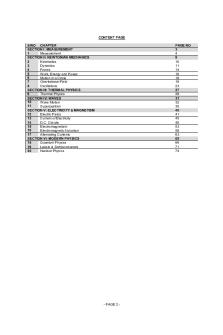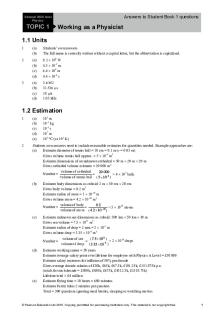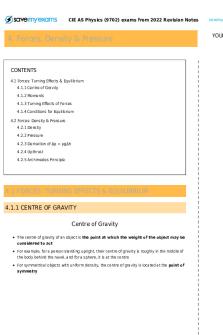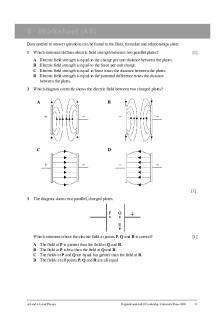AS A Level Topical Physics Notes PDF

| Title | AS A Level Topical Physics Notes |
|---|---|
| Author | FireFrost |
| Course | Differential Equations and Complex Variables |
| Institution | काठमाण्डौ विश्वविद्यालय |
| Pages | 77 |
| File Size | 3.5 MB |
| File Type | |
| Total Downloads | 54 |
| Total Views | 183 |
Summary
Download AS A Level Topical Physics Notes PDF
Description
CONTENT PAGE S/NO CHAPTER SECTION I: MEASUREMENT 1 Measurement SECTION II: NEWTONIAN MECHANICS 2 Kinematics 3 Dynamics 4 Forces 5 Work, Energy and Power 6 Motion in a Circle 7 Gravitational Field 8 Oscillations SECTION III: THERMAL PHYSICS 9 Thermal Physics SECTION IV: WAVES 10 Wave Motion 11 Superposition SECTION V: ELECTRICITY & MAGNETISM 12 Electric Fields 13 Current of Electricity 14 D.C. Circuits 15 Electromagnetism 16 Electromagnetic Induction 17 Alternating Currents SECTION VI: MODERN PHYSICS 18 Quantum Physics 19 Lasers & Semiconductors 20 Nuclear Physics
PAGE NO 3 4 9 10 11 14 16 18 19 23 27 28 31 32 35 40 41 45 49 53 58 63 65 66 71 74
- PAGE 2 -
SECTION I MEASUREMENT
- PAGE 3 -
Chapter 1: Measurement SI Units Errors and Uncertainties Scalars and Vectors a. Recall the following base quantities and their units; mass (kg), length (m), time (s), current (A), temperature (K), amount of substance (mol). SI Units Name metre kilogram second mole Kelvin ampere candela
Base Quantities Length Mass Time Amount of substance Temperature Current Luminous intensity b.
Symbol m kg s mol K A cd
Express derived units as products or quotients of the base units and use the named units listed in „Summary of Key Quantities, Symbols and Units‟ as appropriate. A derived unit can be expressed in terms of products or quotients of base units. Derived Quantities
Equation
Derived Units
Area (A)
2
A=L
m2
Volume (V)
V = L3
m3
Density ()
=
m V L v= t v a= t
kg -3 m3 = kg m m -1 s =ms m s-1 -2 s =ms
p=mxv
(kg)(m s-1) = kg m s-1
Velocity (v) Acceleration (a) Momentum (p)
Derived Quantities
Equation
Force (F)
p F= t
Pressure (p)
p=
F A
Derived Unit Special Name Symbol
Derived Units
Newton
N
kg m s-1 = kg m s-2 s
Pascal
Pa
kg m s-2 -1 -2 m2 = kg m s
Energy (E)
E=Fxd
joule
J
(kg m s-2)(m) = kg m2 s-2
Power (P)
E P=t
watt
W
kg m2 s-2 2 -3 = kg m s s
Frequency (f)
1 f= t
hertz
Hz
1 = s-1 s
Q=Ixt
coulomb
C
As
Potential Difference (V)
E V =Q
volt
V
kg m2 s-2 = kg m2 s-3 A-1 As
Resistance (R)
V R= I
ohm
kg m2 s-3 A-1 = kg m2 s-3 A-2 A
Charge (Q)
- PAGE 4 -
c.
Show an understanding of and use the conventions for labelling graph axes and table columns as set out in the ASE publication SI Units, Signs, Symbols and Systematics (The ASE Companion to 516 Science, 1995). Self-explanatory
d.
Use the following prefixes and their symbols to indicate decimal sub-multiples or multiples of both base and derived units: pico (p), nano (n), micro (), milIi (m), centi (c), deci (d), kilo (K), mega (M), giga (G), tera (T). Multiplying Factor -12 10 10-9 10-6 10-3 -2 10 -1 10 103 106 9 10 1012
e.
Prefix pico nano micro milli centi deci kilo mega giga tera
Symbol p n m c d k M G T
Make reasonable estimates of physical quantities included within the syllabus. When making an estimate, it is only reasonable to give the figure to 1 or at most 2 significant figures since an estimate is not very precise. Physical Quantity Mass of 3 cans (330 ml) of Coke Mass of a medium-sized car Length of a football field Reaction time of a young man
Reasonable Estimate 1 kg 1000 kg 100 m 0.2 s
-
Occasionally, students are asked to estimate the area under a graph. The usual method of counting squares within the enclosed area is used. (eg. Topic 3 (Dynamics), N94P2Q1c)
-
Often, when making an estimate, a formula and a simple calculation may be involved.
EXAMPLE 1E1 Estimate the average running speed of a typical 17-year-old‟s 2.4-km run. velocity =
distance time =
2400 12.5 x 60 = 3.2
3 m s-1 EXAMPLE 1E2 (N08/ I/ 2) Which estimate is realistic?
A
Option The kinetic energy of a bus travelling on an expressway is 30 000 J
B
The power of a domestic light is 300 W.
C
The temperature of a hot oven is 300 K.
Explanation A bus of mass m travelling on an expressway will travel between 50 to 80 km h-1, which is 13.8 to 22.2 m s-1. Thus, its KE will be approximately ½ m(182) = 162m. Thus, for its KE to be 30 000J: 162m = 30 000. Thus, m = 185kg, which is an absurd weight for a bus; ie. This is not a realistic estimate. A single light bulb in the house usually runs at about 20 W to 60 W. Thus, a domestic light is unlikely to run at more than 200W; this estimate is rather high. 300K = 27 0C. Not very hot.
- PAGE 5 -
D
The volume of air in a car tyre is 0.03 m3.
Estimating the width of a tyre, t, is 15 cm or 0.15 m, and estimating R to be 40 cm and r to be 30 cm,
R
r
f. g.
volume of air in a car tyre is 2 2 = π(R – r )t = π(0.42 – 0.32)(0.15) 3 = 0.033 m 3 ≈ 0.03 m (to one sig. fig.)
Show an understanding of the distinction between systematic errors (including zero errors) and random errors. Show an understanding of the distinction between precision and accuracy. Random error is the type of error which causes readings to scatter about the true value. Systematic error is the type of error which causes readings to deviate in one direction from the true value. Precision: refers to the degree of agreement (scatter, spread) of repeated measurements of the same quantity. {NB: regardless of whether or not they are correct.} Accuracy refers to the degree of agreement between the result of a measurement and the true value of the quantity. → → R Error Higher → → → → → → Less Precise → → → → → →S Error Higher → → → → → →Less Accurate → → →
h.
true value
true value
true value
true value
Assess the uncertainty in a derived quantity by simple addition of actual, fractional or percentage uncertainties (a rigorous statistical treatment is not required). For a quantity x = (2.0 0.1) mm, Actual/ Absolute uncertainty, Fractional uncertainty, Percentage uncertainty,
If p =
2x - y 2x + y or p = , 3 3
2x 3 If r = 2xy or r = y3 ,
x Δx x Δx x 100%
= 0.1 mm
Δp
=
Δr r
Δx 3Δy = x + y
= 0.05 =5% 2Δx + Δy 3
Actual error must be recorded to only 1 significant figure, & The number of decimal places a calculated quantity should have is determined by its actual error.
- PAGE 6 -
For eg, suppose g has been initially calculated to be 9.80645 m s-2 & g has been initially calculated to be 0.04848 m s-2. The final value of g must be recorded as 0.05 m s-2 {1 sf }, and the appropriate recording of -2 g is (9.81 0.05) m s . i.
Distinguish between scalar and vector quantities, and give examples of each. Type Definition
Scalar A scalar quantity has a magnitude only. It is completely described by a certain number and a unit.
Vector A vector quantity has both magnitude and direction. It can be described by an arrow whose length represents the magnitude of the vector and the arrow-head represents the direction of the vector.
Examples
Distance, speed, mass, time, temperature, work done, kinetic energy, pressure, power, electric charge etc.
Displacement, velocity, moments (or torque), momentum, force, electric field etc.
Common Error: Students tend to associate kinetic energy and pressure with vectors because of the vector components involved. However, such considerations have no bearings on whether the quantity is a vector or scalar. j. k.
Add and subtract coplanar vectors. Represent a vector as two perpendicular components. In the diagram below, XY represents a flat kite of weight 4.0 N. At a certain instant, XY is inclined at 30 o to the horizontal and the wind exerts a steady force of 6.0 N at right angles to XY so that the kite flies freely. Y
6.0 N
30o X
4.0 N By accurate scale drawing
By calculations using sine and cosine rules, or Pythagoras‟ theorem
Draw a scale diagram to find the magnitude and direction of the resultant force acting on the kite.
resultant, R
Scale: 1 cm 1.0 N resultant, R
4.0 N
6.0 N 30o
6.0 N 4.0 N 30
Using cosine rule,
o
- PAGE 7 -
2
2
2
a = b + c – 2bc cos A R2 = 42 + 62 -2(4)(6)(cos 30°) R = 3.23 N
R = 3.2 N ( 3.2 cm) at = 1120 to the 4 N vector.
Summing Vector Components Y
6.0 N
b a sin A = sin B 6 3.23 = sin 30° sin = 68° or 112° = 112° to the 4 N vector
Using sine rule,
Fx = - 6 sin 300 =-3N 0
Fy = 6 cos 30 - 4 = 1.2 N
2
30
R = (-3) + (1.2) = 3.23 N
o
X
4.0 N
2
1.2 tan = 3 = 220 R is at an angle 1120 to the 4 N vector. (900 + 220)
- PAGE 8 -
SECTION II NEWTONIAN MECHANICS
- PAGE 9 -
Chapter 2: Kinematics Rectilinear Motion Non-linear Motion a. Define displacement, speed, velocity and acceleration.
b.
Distance:
Total length covered irrespective of the direction of motion.
Displacement:
Distance moved in a certain direction
Speed:
Distance travelled per unit time.
Velocity:
is defined as the rate of change of displacement, or, displacement per unit time {NOT: displacement over time, nor, displacement per second, nor, rate of change of displacement per unit time}
Acceleration:
is defined as the rate of change of velocity.
Use graphical methods to represent distance travelled, displacement, speed, velocity and acceleration. Self-explanatory
c.
Find displacement from the area under a velocity-time graph. The area under a velocity-time graph is the change in displacement.
d.
Use the slope of a displacement-time graph to find velocity. The gradient of a displacement-time graph is the {instantaneous} velocity.
e.
Use the slope of a velocity-time graph to find acceleration. The gradient of a velocity-time graph is the acceleration.
f. g.
Derive, from the definitions of velocity and acceleration, equations that represent uniformly accelerated motion in a straight line. Solve problems using equations which represent uniformly accelerated motion in a straight line, including the motion of bodies falling in a uniform gravitational field without acceleration. 1. 2. 3. 4.
v = u +a t: s = ½ (u + v) t: 2 2 v = u + 2 a s: s = u t + ½ a t2:
derived from definition of acceleration: a = (v – u) / t derived from the area under the v-t graph derived from equations (1) and (2) derived from equations (1) and (2)
These equations apply only if the motion takes place along a straight line and the acceleration is constan {hence, for eg., air resistance must be negligible.} h.
Describe qualitatively the motion of bodies falling in a uniform gravitational field with air resistance. Consider a body moving in a uniform gravitational field under 2 different conditions: A
WITHOUT AIR RESISTANCE Highest point +ve
v
Moving up
Moving down
t W
Assuming negligible air resistance, whether the body is moving up, or at the highest point or moving down, the weight of the body, W, is the only force acting on it, causing it to experience a constant acceleration. Thus, the gradient of the v-t graph is constant throughout its rise and fall. The body is said to undergo free
- PAGE 10 -
fall.
B
WITH AIR RESISTANCE Highest point
v Terminal velocity
Moving up Moving down
t
If air resistance is NOT negligible and if it is projected upwards with the same initial velocity, as the body moves upwards, both air resistance and weight act downwards. Thus its speed will decrease at a rate greater than 9.81 m s-2 . This causes the time taken to reach its maximum height reached to be lower than in the case with no air resistance. The max height reached is also reduced. At the highest point, the body is momentarily at rest; air resistance becomes zero and hence the only force acting on it is the weight. The acceleration is thus 9.81 m s-2 at this point. -2
As a body falls, air resistance opposes its weight. The downward acceleration is thus less than 9.81 m s . As air resistance increases with speed (Topic 5), it eventually equals its weight (but in opposite direction). From then there will be no resultant force acting on the body and it will fall with a constant speed, called the terminal velocity. i.
Describe and explain motion due to a uniform velocity in one direction and uniform acceleration in a perpendicular direction. Equations that are used to describe the horizontal and vertical motion x direction (horizontal – axis)
y direction (vertical – axis)
s x = ux t s (displacement)
s y = uy t +
1 a t2 2 y
1 s x = u x t + a x t2 2
(Note: If projectile ends at same level as the start, then sy = 0)
u (initial velocity)
ux
uy
v (final velocity)
vx = ux + axt
a (acceleration)
t (time)
vy = uy + at
(Note: At max height, vx = 0)
2
2
vy = uy + 2 a sy
ax
ay
(Note: Exists when a force in x direction present)
(Note: If object is falling, then ay = -g)
t
t
vy Parabolic Motion: tan = v x
sy : direction of tangential velocity {NOT: tan = s } x
- PAGE 11 -
Chapter 3: Dynamics Newton‟s laws of motion Linear momentum and its conservation a. State each of Newton‟s laws of motion. Newton‟s First Law Every body continues in a state of rest or uniform motion in a straight line unless a net (external) force acts on it. Newton‟s Second Law The rate of change of momentum of a body is directly proportional to the net force acting on the body, and the momentum change takes place in the direction of the net force. Newton‟s Third Law When object X exerts a force on object Y, object Y exerts a force of the same type that is equal in magnitude and opposite in direction on object X. The two forces ALWAYS act on different objects and they form an action-reaction pair. b.
Show an understanding that mass is the property of a body which resists change in motion. Mass:
c.
is a measure of the amount of matter in a body, & is the property of a body which resists change in motion.
Describe and use the concept of weight as the effect of a gravitational field on a mass. Weight: is the force of gravitational attraction (exerted by the Earth) on a body.
d.
Define linear momentum and impulse. Linear momentum of a body is defined as the product of its mass and velocity ie p = m v Impulse of a force I is defined as the product of the force and the time t during which it acts ie I = F x t
{for force which is const over the duration t}
For a variable force, the impulse = Area under the F-t graph { Fdt; may need to “count squares”} Impulse is equal in magnitude to the change in momentum of the body acted on by the force. Hence the change in momentum of the body is equal in mag to the area under a (net) force-time graph. {Incorrect to define impulse as change in momentum} e.
Define force as rate of change of momentum. Force is defined as the rate of change of momentum, ie F =
dm m(v - u) = ma or F = v t dt
The {one} Newton is defined as the force needed to accelerate a mass of 1 kg by 1 m s-2. f.
Recall and solve problems using the relationship F = ma appreciating that force and acceleration are always in the same direction. Self-explanatory
g.
State the principle of conservation of momentum. Principle of Conservation of Linear Momentum: When objects of a system interact, their total momentum before and after interaction are equal if no net (external) force acts on the system. or, ie
The total momentum of an isolated system is constant m1 u1 + m2 u2 = m1 v1 + m2 v2 if net F = 0 {for all collisions }
NB: Total momentum DURING the interaction/collision is also conserved. h.
Apply the principle of conservation of momentum to solve problems including elastic and inelastic
- PAGE 12 -
interactions between two bodies in one dimension. (Knowledge of coefficient of restitution is not required.)
i.
(Perfectly) elastic collision:
Both momentum & kinetic energy of the system are conserved.
Inelastic collision:
Only momentum is conserved, total kinetic energy is not conserved.
Perfectly inelastic collision:
Only momentum is conserved, and the particles stick together after collision. (i.e. move with the same velocity.)
Recognise that, for a perfectly elastic collision between two bodies, the relative speed of approach is equal to the relative speech of separation. For all elastic collisions, u1 – u2 = v2 – v1 ie. relative speed of approach = relative speed of separation or,
j.
2
2
2
2
½ m1u1 + ½ m2u2 = ½ m1v1 + ½ m2v2
Show an understanding that, whilst the momentum of a system is always conserved in interactions between bodies, some change in kinetic energy usually takes place. In inelastic collisions, total energy is conserved but Kinetic Energy may be converted into other forms of energy such as sound and heat energy.
- PAGE 13 -
Chapter 4: Forces Types of force Equilibrium of force Centre of gravity Turning effects of forces a. Recall and apply Hooke‟s Law to new situations or to solve related problems. Within the limit of proportionality, the extension produced in a material is directly proportional to the force/load applied ie
F = kx
Force constant k = force per unit extension (F/x) {N08P3Q6b(ii)} b.
Deduce the elastic potential energy in a deformed material from the area under a force-extension graph. Elastic potential energy/strain energy = Area under the F-x graph {May need to “count the squares”} For a material that obeys Hooke‟s law, Elastic Potential Energy, E = ½ F x = ½ k x2
c.
Describe the forces on mass, charge and current in gravitational, electric and magnetic fields, as appropriate. Forces on Masses in Gravitational Fields - A region of space in w...
Similar Free PDFs

AS A Level Topical Physics Notes
- 77 Pages

AS Physics Practical Notes
- 3 Pages

A Level Biology - Enzymes notes
- 2 Pages

A Level Biology - Water notes
- 2 Pages

AQA A-level Economics notes
- 395 Pages

Contract Law Notes A Level
- 162 Pages
Popular Institutions
- Tinajero National High School - Annex
- Politeknik Caltex Riau
- Yokohama City University
- SGT University
- University of Al-Qadisiyah
- Divine Word College of Vigan
- Techniek College Rotterdam
- Universidade de Santiago
- Universiti Teknologi MARA Cawangan Johor Kampus Pasir Gudang
- Poltekkes Kemenkes Yogyakarta
- Baguio City National High School
- Colegio san marcos
- preparatoria uno
- Centro de Bachillerato Tecnológico Industrial y de Servicios No. 107
- Dalian Maritime University
- Quang Trung Secondary School
- Colegio Tecnológico en Informática
- Corporación Regional de Educación Superior
- Grupo CEDVA
- Dar Al Uloom University
- Centro de Estudios Preuniversitarios de la Universidad Nacional de Ingeniería
- 上智大学
- Aakash International School, Nuna Majara
- San Felipe Neri Catholic School
- Kang Chiao International School - New Taipei City
- Misamis Occidental National High School
- Institución Educativa Escuela Normal Juan Ladrilleros
- Kolehiyo ng Pantukan
- Batanes State College
- Instituto Continental
- Sekolah Menengah Kejuruan Kesehatan Kaltara (Tarakan)
- Colegio de La Inmaculada Concepcion - Cebu









